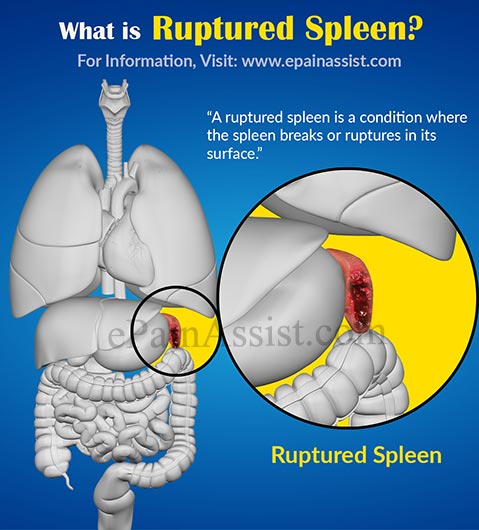What is Ruptured Spleen?
A ruptured spleen is a condition where the spleen breaks or ruptures in its surface. It is a medical emergency and prompt medical attention should be sought. The spleen is located just below the rib cage on the left side. The function of the spleen is helping the body in fighting infection and filtering old blood cells from the bloodstream. The common cause of a ruptured spleen is a forceful or traumatic blow to the abdomen as seen in a sporting accident, a car crash, or a fistfight. If a ruptured spleen is not treated immediately, then it can cause life-threatening internal bleeding into the abdomen. Even though ruptured spleen needs emergency surgery, there are some patients with ruptured spleen who can be treated with inpatient hospital care.
Causes of Ruptured Spleen
- Heavy blow, injury, or trauma to the left side of the body.
- Spleen enlargement, as seen in conditions where the blood cells accumulate in the spleen and other medical conditions such as mononucleosis, liver disease, blood cancers and other infections.
Signs and Symptoms of Ruptured Spleen
- Pain in the left upper region of the abdomen.
- Tenderness to touch on the upper left region of the abdomen.
- Lightheadedness.
- Confusion.
- Serious symptoms indicating internal bleeding include: Lightheadedness, confusion, blurred/disturbed vision and fainting.
Tests to Diagnose Ruptured Spleen
- Physical exam where the doctor palpates the abdomen to determine the size of the spleen and any abdominal tenderness.
- A procedure is done where fluid is drawn from the abdomen using a needle. This fluid is tested and if it reveals blood in the abdomen, then the patient may be referred for emergency treatment.
- Imaging tests of the abdomen such as an abdominal CT scan to determine or rule out other likely causes of the symptoms.
Treatment for Ruptured Spleen
Treatment depends on the patient’s condition. Some patients may require immediate surgery, whereas, in some patients, a ruptured spleen heals with proper rest and time.
- Hospitalization is required for the spleen to heal. Doctors monitor the patient’s condition and provide nonsurgical care, such as blood transfusions, if required.
- Periodic follow-up CT scans may be recommended to ensure that the spleen has healed completely.
Surgery May be Required to Repair or Remove the Spleen and Comprises of:
- Surgery is done to repair the spleen using stitches.
- Surgery is done to remove only a part of the spleen and this procedure is called as partial or subtotal splenectomy.
- Surgery to remove the entire spleen, i.e., splenectomy. Spleen is not mandatory for survival; however, absence of the spleen increases the risk of serious infections.
- Surgery to repair or remove the spleen is commonly done laparoscopically, i.e. Laparoscopic Surgery, where several, small incisions are made in the abdomen. Special surgical tools and a camera lens with a light are inserted through the incisions and the camera delivers images on a monitor, so that the surgeon can monitor and guide the surgical tools. Sometimes, a large incision is also made for accessing the spleen.
Prevention of Ruptured Spleen
Patients with an enlarged spleen should avoid activities, which could cause a ruptured spleen. Patients with mononucleosis should avoid contact sports and other activities, which increase the risk of abdominal trauma. The spleen should be safeguarded from blows or bumps so that the risk of the spleen rupturing is reduced.

